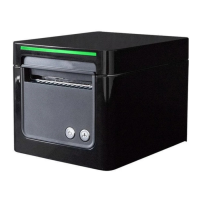Define user-defined Kanji characters
The ranges of c1 and c2 differ, depending on models and the character code
system used. The ranges of c1 and c2 for each model are as follows.
0 ≤ d ≤ 255
Defines the user-defined Kanji character pattern specified by the character
codes (c1 and c2) of the currently selected Kanji font.
•
c1 specifies the first byte of a character code for a user-defined Kanji
character.
•
c2 specifies the second byte of a character code for a user-defined Kanji
character.
•
d specifies the defined data (column format).
•
k indicates the number of defined data. k is an explanation parameter;
therefore, it does not need to be transmitted.
■ This command is effective only for the Japanese, Simplified Chinese, Traditional
Chinese, and Korean models.
■ The printer processes k byte data of d1...dk as defined data. The defined data (d)
sets a corresponding bit to 1 to print a dot or to 0 not to print a dot.
■ The number of characters to be defined differ, depending on the printer models.
■ Different user-defined characters can be defined for each Kanji character. Kanji
fonts can be specified by function 48 of FS ( A.
■ Defined data is effective until it is redefined, ESC @ is executed, the printer is
reset, or the power is turned off.
■ User-defined characters are not defined and space is printed at the default.
Japanese model (JIS code)
Japanese model (SHIFT JIS code)
40H
c2
7EH,
80H
c2
9EH
Traditional Chinese model

